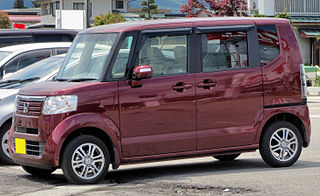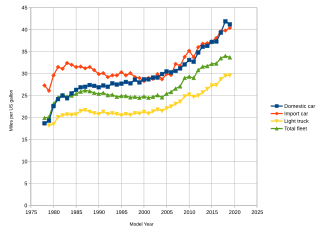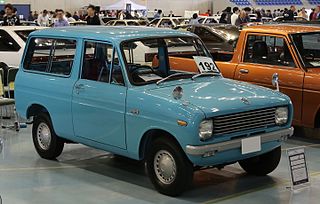Related Research Articles

Minivan is a car classification for vehicles designed to transport passengers in the rear seating row(s), with reconfigurable seats in two or three rows. The equivalent classification in Europe is MPV or M-segment.

A sport utility vehicle (SUV) is a car classification that combines elements of road-going passenger cars with features from off-road vehicles, such as raised ground clearance and four-wheel drive.

A van is a type of road vehicle used for transporting goods or people. Depending on the type of van, it can be bigger or smaller than a pickup truck and SUV, and bigger than a common car. There is some variation in the scope of the word across the different English-speaking countries. The smallest vans, microvans, are used for transporting either goods or people in tiny quantities. Mini MPVs, compact MPVs, and MPVs are all small vans usually used for transporting people in small quantities. Larger vans with passenger seats are used for institutional purposes, such as transporting students. Larger vans with only front seats are often used for business purposes, to carry goods and equipment. Specially equipped vans are used by television stations as mobile studios. Postal services and courier companies use large step vans to deliver packages.

Kei car is the smallest category of Japanese, expressway-legal motor vehicles. 'Kei' is diminutive for kei-jidōsha,, "light automobile" or "compact automobile". With restricted dimensions and engine specifications, owners benefit firstly from lower taxes and insurance rates. And in most rural areas, importantly, they were also exempted from the general Japanese shako shōmeisho (車庫証明書) parking-space ownership requirement to legally buy a motor vehicle at all, as street parking is generally restricted in Japan. Japan's carmakers also make microvans and kei trucks within this legal category.
Governments and private organizations have developed car classification schemes that are used for various purposes including regulation, description, and categorization of cars.

Corporate average fuel economy (CAFE) standards are regulations in the United States, first enacted by the United States Congress in 1975, after the 1973–74 Arab Oil Embargo, to improve the average fuel economy of cars and light trucks produced for sale in the United States. More recently, efficiency standards were developed and implemented for heavy-duty pickup trucks and commercial medium-duty and heavy-duty vehicles.

Crash incompatibility, crash compatibility, vehicle incompatibility, and vehicle compatibility are terms in the automobile crash testing industry. They refer to the tendency of some vehicles to inflict more damage on another vehicle in two-car crashes. Vehicle incompatibility is said to lead to more dangerous, fatal crashes, while compatibility can prevent injury in otherwise comparable crashes.

Compact car is a vehicle size class—predominantly used in North America—that sits between subcompact cars and mid-size cars. "Small family car" is a British term and a part of the C-segment in the European car classification. However, before the downsizing of the United States car industry in the 1970s and 1980s, larger vehicles with wheelbases up to 110 in (2.79 m) were considered "compact cars" in the United States.

The Mazda Porter and Porter Cab are a series of small kei trucks that were produced from 1961 to 1989 by Mazda, mainly for sale in the domestic Japanese market. Export versions of the Porter were labelled E360. The Porter was replaced by the Autozam Scrum, a rebadged Suzuki Carry.

In Japan, the national government issues vehicle registration plates for motor vehicles through the Ministry of Land, Infrastructure, Transport and Tourism Land Transportation Offices nationwide. However, the local municipality rather than the national government registers certain vehicles with small engine displacements.

The Ford Excursion is a heavy-duty SUV that was sold by Ford Motor Company from 2000 to 2005. At the time of its introduction, the Excursion was the longest and heaviest SUV ever to enter mass production. The third Ford SUV derived from the F-Series pickup trucks, the model line used a heavier-duty chassis and frame than the Expedition; both vehicles competed against the Chevrolet Suburban.

The Mitsubishi Minica is a kei car produced by Mitsubishi Motors mainly for the Japanese domestic market from 1962 to 2011. It was first built by Shin Mitsubishi Heavy-Industries, one of Mitsubishi Heavy Industries' three regional automotive companies until they were merged in 1964, and as such predates MMC itself. In Japan, it was sold at a specific retail chain called Galant Shop. In 2007 and 2011, the car was replaced with the Mitsubishi eK and the Mitsubishi i.

A compact sport utility vehicle or compact SUV is a class of small sport utility vehicles that is larger than mini SUVs, but smaller than mid-size SUVs. However, there is no official definition of the size or dimensions for this market segment. Moreover, some manufacturers have marketed the same model name on different sized vehicles over time. The most common distinction between versions of crossover automobiles and compact-sized SUVs is that the first is based on a car-based unibody platform, while an SUV uses the unibody with welded-in ladder frame or body-on-frame chassis commonly used on trucks. However, manufacturers and common usage has blurred the two terms. Many recent vehicles labelled as compact SUVs are technically compact crossovers and are built on the platform of a compact/C-segment passenger car, while some models may be based on a mid-size car (D-segment) or a B-segment platform.
Road tax, known by various names around the world, is a tax which has to be paid on, or included with, a motorised vehicle to use it on a public road.

The Daihatsu Hijet is a cab over microvan and kei truck produced and sold by the Japanese automaker Daihatsu since 1960. Despite the similarities between the Hijet name and Toyota's naming scheme for its trucks and vans, the name "Hijet" has been in use for Daihatsu's kei trucks and microvans since 1960, over two decades before Toyota took control. "Hijet", when transliterated into Japanese, is very similar to "Midget", one of Daihatsu's other mini-trucks. According to Daihatsu, the name "Hijet" was created to imply that the vehicle offers higher performance than the Midget. The Hijet competes in Japan with the Honda Acty, Mitsubishi Minicab, Nissan Clipper, Subaru Sambar and Suzuki Carry.

A microvan is a van or minivan which is within the Japanese kei car classification or similar, and is smaller than a mini MPV. In China, these vehicles are nicknamed miàn bāo chē because of their shape. Similarly, in several Hispanic American countries, these vehicles are called pan de molde, which means "bread loaf". In Indonesia, it is commonly called a minibus due to their tall roof, perceived as resembling a miniature bus; the term is also used generally to refer to any type of three-row MPVs.
Truck classifications are typically based upon the maximum loaded weight of the truck, typically using the gross vehicle weight rating (GVWR) and sometimes also the gross trailer weight rating (GTWR), and can vary among jurisdictions.

A kei truck, kei-class truck, or Japanese mini truck is a mini truck, a type of pickup truck available in rear-wheel drive or four-wheel drive versions, built to satisfy the Japanese keijidōsha statutory class. They are known as keitora in Japan alongside the microvan.

JAC Group is a Chinese automobile and commercial vehicle manufacturer. The company is based in Hefei, Anhui Province, China.
Dongfeng Sokon Automobile known internationally as DFSK Motor, was a joint venture between Dongfeng and Seres Group, formed on June 27, 2003. It is now fully owned by Seres.
References
- 1 2 "Ratings – How does NHTSA categorize vehicles?". National Highway Traffic Safety Administration . Retrieved 24 March 2019.
- 1 2 "Vehicle Inventory and Use Survey (VIUS)". U.S. Census Bureau . Retrieved 12 July 2019.
- 1 2 "How IIHS Classifies Vehicles by Size, Weight, Type and Price". US: Insurance Institute for Highway Safety . Retrieved 24 March 2019.
- ↑ "40 CFR 600.315-08 - Classes of comparable automobiles. - Content Details - CFR-2011-title40-vol30-sec600-315-08". www.govinfo.gov. Retrieved 15 July 2019.
- 1 2 "Frequently Asked Questions". www.fueleconomy.gov. U.S. Department of Energy. Retrieved 7 June 2016. Click "How are vehicle size classes defined?"
{{cite web}}: CS1 maint: postscript (link) - ↑ Title 40 CFR § 600.315-08 - Classes of comparable automobiles. U.S. Government Publishing Office. 1 July 2015. Retrieved 16 April 2018.
- 1 2 "Chapter 2. Introduction to Vehicle Classification - Verification, Refinement, and Applicability of Long-Term Pavement Performance Vehicle Classification Rules, November 2014 - FHWA-HRT-13-091". FHWA .
- ↑ "IIHS vehicle classifications" (PDF). US: Insurance Institute for Highway Safety . Retrieved 13 July 2019.
- ↑ "On-Road Vehicle and Engine Emission Regulations (SOR/2003-2)". www.ec.gc.ca. Environment Canada. Archived from the original on 12 October 2004.
- ↑ "Regulation (EEC) No 4064/89 - Merger Procedure" (PDF). Office for Official Publications of the European Communities L-2985 Luxembourg. Retrieved 6 April 2019.
exact market definition was left open .. boundaries between segments are blurred by factors other than the size or length of cars
- ↑ Road Vehicle Act of 1951 (Japanese)
- ↑ Japanese Postwar Reconstruction
- ↑ "SUV sizes compared: Small/medium/large/XL, which is best?". CarExpert. 2022-07-16. Retrieved 2024-03-20.